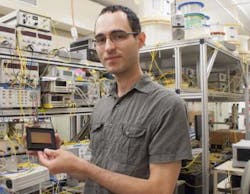Chalcogenide optical chips, carbon-nanotube lasers form optical oscilloscope
An optical oscilloscope with 20 times the resolution of conventional electronics has been developed by the ARC Centre for ultrahigh bandwidth devices for optical systems (CUDOS) at the University of Sydney and the Australian National University (Canberra).
The laser used for optical data analysis in the oscilloscope is based on carbon-nanotube short-pulse technology developed and patented by Alnair Labs (Tokyo, Japan). The result is an instrument capable of directly resolving the terabit data signals being researched for next-generation fiber-optic "superchannels."
The CUDOS/Alnair partnership is leading to Australian production of the next-generation photonics involved.
An article on the development of the oscilloscope was presented Friday, 14 November in a session of the Asia Communications and Photonics Conference (ACP; 11-14 November, 2014; Shanghai, China), an annual gathering of researchers worldwide in photonics and communications.
"This is the culmination of four years of research and discussion with our industry partners," says Simon Lefrancois, from the University of Sydney's School of Physics, and lead author of the article that was presented. "The ultrahigh resolution we have achieved is made possible by directly analyzing the optical data with a laser beam rather than converting it to a slower electric signal. Our specialty glass greatly enhances the sensitivity of this interaction so that it can be done with low powers on a compact optical chip."
Chalcogenide optical chips
CUDOS is providing the chalcogenide glass optical chips using unique nanofabrication capabilities developed in Australia.
"[Development of the optical oscilloscope] opens the way for jump-starting the creation of an Australian optical chip foundry based on the local manufacture of highly specialized glasses used for low-power, high-speed processing on compact chips," says professor Ben Eggleton, director of CUDOS. "We are well advanced in our talks with Alnair Labs about commercial-scale supply of this technology."
The opening in 2015 of the Australian Institute for Nanoscience at the University of Sydney and the Australian National Fabrication Facility node at the Australian National University means Australia is well-positioned to produce the technology developed by this research.

John Wallace | Senior Technical Editor (1998-2022)
John Wallace was with Laser Focus World for nearly 25 years, retiring in late June 2022. He obtained a bachelor's degree in mechanical engineering and physics at Rutgers University and a master's in optical engineering at the University of Rochester. Before becoming an editor, John worked as an engineer at RCA, Exxon, Eastman Kodak, and GCA Corporation.
